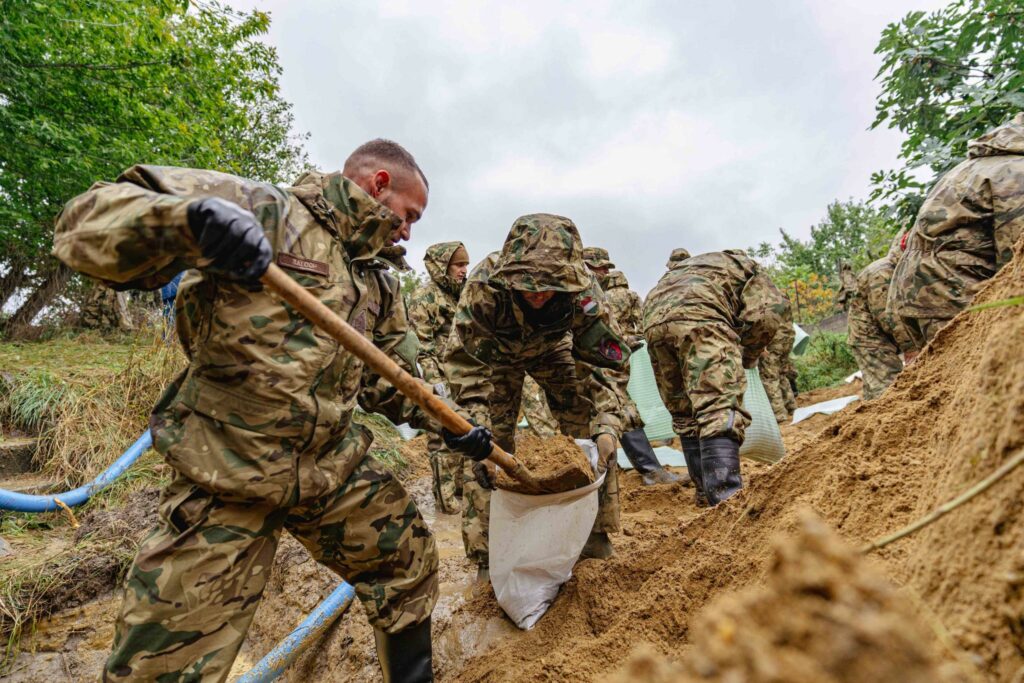The https://english.atlatszo.hu use cookies to track and profile customers such as action tags and pixel tracking on our website to assist our marketing. On our website we use technical, analytical, marketing and preference cookies. These are necessary for our site to work properly and to give us inforamation about how our site is used. See Cookies Policy
“Better late than never” – late deployment of reserve troops to fight flood drives criticism
As Hungary was hit by a historic flood, the Hungarian Defense Force played a key role in dam building and disaster relief. By mid-week, mainly contract soldiers are deployed, although government leaders claim widely different figures about their numbers. The newly expanded reserve force’s deployment appears to be less swift, as indicated by an email obtained by Átlátszó.
“17 000 reservists have been called up”; “1 400 soldiers are helping with the defense along the Danube”; and “4 000 soldiers can be mobilized within 24 hours” – these are just some of the figures that have been quoted by state officials in recent days about the number of soldiers working on flood defense. The deployment of Hungarian Defence Forces quickly turned into a political controversy when opposition party leader Péter Magyar questioned government ministers about the scale and speed of the mobilization, quoting an email that suggested that the reservists were only called to the dams at the last minute, and on a strictly voluntary basis.

The purported email read that „the possibility of calling reserve soldiers to reinforce flood defense tasks was raised.” It then asked reservists if they could participate in dam expansion work from 19 September, „the exact terms of reference for participation are currently being finalized.”
The email was allegedly sent on the 16th of September and gave soldiers a 1-day deadline to volunteer for flood relief. The email address quoted indicates that it was sent out by a territorial defense battalion based in and around Budapest. This suggests that the soldiers were indeed called in at the last moment since the flood was expected to peak in the region in the following two days.
Short notice
Átlátszó was not able to verify the authenticity of Mr. Magyar’s email, however, a similar email obtained from a source close to the reservist forces shows similar details.
“We ask everyone that the flooding is a national issue, so whoever can, please come forward”
– reads this e-mail, sent out on 17 September from the official e-mail address of one of the Baranya County Territorial Protection Battalions. Soldiers were given until the next day to apply, and those who received the letter in time could indicate their intention to participate by filling in a Google form.
According to the e-mail from Baranya, the actual work will start later, on 20 September. The National Hydrometeorological Service forecasts that the Danube is rising to 800 cm predicted at that day in the region, which means a level 1 alert. The flood is expected to peak on the 23rd of September.
Our source criticized the mobilization plan as “Better late than never. Once again, there was a last-minute call from above to do something”.
Looking for volunteers
Hungary’s current reservist territorial defense force was established in 2018. Territorial defense reservists, who are organized in local units, work civilian jobs but are called for short-term service (about 3 days every two months) regularly. They may also be deployed in emergencies such as in a state of war or during natural disasters.
In 2023, the government started a massive campaign to to expand this reserve force, which included extra university credits for those who signed up.
Currently, the force has over 10 thousand members.
As our source explained, it has been common for territorial defense commanders to ask for volunteers for tasks; mandatory calls to report have been rarer, mostly confined to large military exercises. However, even mandatory calls can be postponed if a soldier is unable to report in time: a medical or employer’s certificate can be used to get an exemption, and the same amount of service has to be completed at a later time.
Our source said that there have been issues with national-level call-ups in the past, for example, soldiers received the order to attend a military exercise with only a one-day notice, which led to some of them missing the event.
Widely differing numbers
In government communications, quite different figures have been published on the number of soldiers involved in flood defenses. The largest number was announced by Csaba Dömötör on Monday morning, who wrote that “the Hungarian Defence Forces are providing 17,000 men, vehicles and helicopters for flood protection.” 17,000 soldiers would be almost a third of the active and reserve personnel of the Defence Forces – in contrast, also on Monday, Defence Minister Kristóf Szalay-Bobrovniczky said that 367 soldiers were currently serving on the dams.
By the evening, the government’s Facebook page was saying that “we can mobilize 4,000 troops for flood protection within 24 hours.” The next day, on 17 September, the Hungarian Defence Forces reported that 1,400 soldiers were on duty at the dams – that’s 1 soldier every 2 kilometers along the Hungarian stretch of the Danube. Later on the government’s page, the same figure was also reported. A day later, on the morning of 19 September, the government posted that
“5,828 professionals are working on the dams” and “15,353 volunteers can be mobilized if necessary”.
Where this latter figure came from is unclear. In order of magnitude, it could be the total number of reserve soldiers, but it is unlikely that all of them would reach the dams in time.
To clarify the situation, we have emailed questions to the Ministry of Defence Press Office about the number of soldiers deployed, but so far we have not received answers.
Written and translated by Zalán Zubor. The Hungarian version of this story is here. Cover image: Hungarian Army / Facebook

